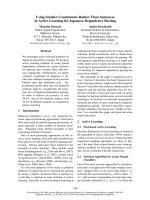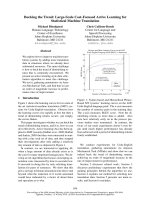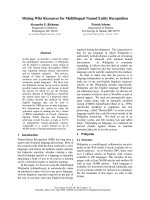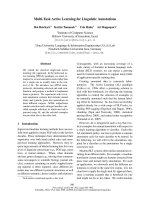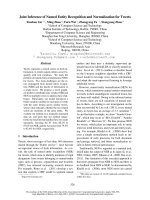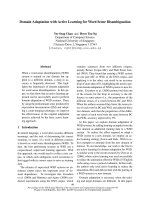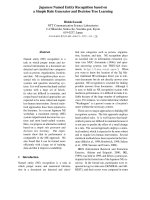Multi criteria based active learning for named entity recognition
Bạn đang xem bản rút gọn của tài liệu. Xem và tải ngay bản đầy đủ của tài liệu tại đây (872.85 KB, 71 trang )
MULTI-CRITERIA-BASED ACTIVE LEARNING FOR
NAMED ENTITY RECOGNITION
SHEN DAN
(B.Eng., SJTU, PRC)
A THESIS SUBMITTED
FOR THE DEGREE OF MASTER OF SCIENCE
DEPARTMENT OF COMPUTER SCIENCE
SCHOOL OF COMPUTING
NATIONAL UNIVERSITY OF SINGAPORE
2004
Name:
Degree:
Dept:
Thesis Title:
Shen Dan
M.Sc.
Computer Science, School of Computing
Multi-Criteria-based Active Learning for Named Entity Recognition
ABSTRACT
In this thesis, we propose a multi-criteria-based active learning approach and effectively
apply it to the task of named entity recognition. Active learning targets to minimize the
human annotation efforts to learn a model with the same performance level as supervised
learning by selecting the most useful examples for labeling. To maximize the contribution
of the selected examples, we consider the multiple criteria including informativeness,
representativeness and diversity and propose some measurements to quantify them
respectively in the SVM-based named entity recognition. More comprehensively, we
effectively incorporate all the criteria using two active learning strategies, both of which
result in less labeling cost than the single-criterion-based method. The best results show
that the labeling cost can be reduced by 95% in the newswire domain and 86% in the
biomedical domain without degrading the performance of the named entity recognizer. To
our best knowledge, this is not only the first work to incorporate the multiple criteria in
active learning but also the first work to study active learning for named entity recognition.
Furthermore, since the above measurements and active learning strategies are quite
general, they can also be easily adapted to other natural language processing tasks.
Keywords:
active learning, named entity recognition, multiple criteria, informativeness,
representativeness, diversity
ii
ACKNOWLEDGEMENTS
I would like to thank my supervisor, Dr. Su Jian, who has the largest immediate influence
on this thesis, for her invaluable motivation, advice, comments throughout my research
and my co-supervisor, Prof. Tan Chew Lim for his endless support and encouragement. I
would also like to thank Dr. Zhou Guo Dong for his suggestion and comments regarding
this thesis.
I gratefully acknowledge the financial support of National University of Singapore in the
form of a research scholarship. I would also like to express my gratitude to Institute for
Infocomm Research which provides me an excellent environment and facilities to study
and research.
Special gratitude goes to Mr. Zhang Jie. Without his encouragement and support on the
experiment, my research could not have been so smooth. It has been great pleasure
working with him. I would also like to thank all my friends, Mr. Yang Xiao Feng, Mr.
Hong Hua Qing, Ms. Xiao Juan and Mr. Niu Zheng Yu in the natural language synergy
lab for their help, which make these 18 months a wonderful experience.
Last but not least, I would like to express my sincerest thanks to my parents. Their love
and understanding are my impetus to do the research during my graduate studies.
iii
TABLE OF CONTENTS
SUMMARY ...................................................................................................................... vii
LIST OF TABLES .............................................................................................................ix
LIST OF FIGURES ............................................................................................................x
INTRODUCTION.......................................................................................................... - 1 1.1 Motivation ......................................................................................................... - 1 1.2 Background....................................................................................................... - 2 1.3 Related Work.................................................................................................... - 3 1.3.1 Committee-based Active Learning ............................................. - 4 1.3.2 Certainty-based Active Learning................................................ - 6 1.4 Contribution.................................................................................................... - 11 1.5 Organization of the Thesis............................................................................. - 13 SVM AND NAMED ENTITY RECOGNITION ...................................................... - 14 2.1 SVM ................................................................................................................. - 14 2.2 Named Entity Recognition............................................................................. - 16 2.2.1 Definition of Named Entity Recognition .................................. - 17 2.2.2 Features ....................................................................................... - 18 2.3 Active Learning for Named Entity Recognition.......................................... - 25 MULTIPLE CRITERIA FOR ACTIVE LEARNING............................................. - 28 3.1 Informativeness .............................................................................................. - 28 3.1.1 Informativeness Measurement for Word................................. - 28 -
iv
3.1.2 Informativeness Measurement for Named Entity ................... - 30 3.2 Representativeness ......................................................................................... - 31 3.2.1 Similarity Measurement between Words................................. - 32 3.2.2 Similarity Measurement between Named Entities .................. - 33 3.2.3 Representativeness Measurement for Named Entity.............. - 38 3.3 Diversity .......................................................................................................... - 39 3.3.1 Global Consideration ................................................................. - 39 3.3.2 Local Consideration ................................................................... - 40 ACTIVE LEARNING STRATEGIES....................................................................... - 43 4.1 Strategy 1......................................................................................................... - 43 4.2 Strategy 2......................................................................................................... - 44 EXPERIMENTATION ............................................................................................... - 46 5.1 Data set ............................................................................................................ - 46 5.1.1 MUC-6 corpus .......................................................................... - 46 5.1.2 GENIA corpus .......................................................................... - 47 5.2 Experiment Setting......................................................................................... - 47 5.3 Experiment Result.......................................................................................... - 48 5.3.1 Overall Experiment Results....................................................... - 49 5.3.2 Effectiveness of Single-Criterion-based Active Learning ....... - 50 5.3.3 Effectiveness of Multi-Criteria-based Active Learning .......... - 52 CONCLUSION ............................................................................................................ - 54 6.1 Conclusions ..................................................................................................... - 54 6.2 Future Work ................................................................................................... - 55 6.3 Dissemination of Results ................................................................................ - 55 v
REFERENCES............................................................................................................. - 57 -
vi
SUMMARY
Named entity recognition (NER) is a fundamental step to many natural language
processing tasks. In recent years, more and more NER systems are developed using
machine learning methods. In order to achieve the best performance, the systems are
generally trained on a large human annotated corpus. However, since annotating such a
corpus is very expensive and time-consuming, it is difficult to adapt the existing NER
systems to a new application or domain. In order to overcome the difficulty, we try to
develop automated methods to reduce the training cost without degrading the performance
by using active learning.
Active learning is based on the assumption that a small number of annotated examples and
a large number of unannotated examples are available. It selects examples actively and
trains a model progressively to avoid redundantly labeling the examples which make little
contribution to the model. For efficiency, a batch of examples is often selected at a time,
which is called batch-based active learning. Different from some simple tasks, such as
text classification, we define an example as a word sequence (named entity) in NER. In
order to minimize the human annotation efforts, we propose a new multi-criteria-based
active learning method based on the comprehensive criteria including informativeness,
representativeness and diversity to select the most useful examples in the training process.
Firstly, the informativeness criterion concerns the examples for which the current model
are most uncertain. We propose three scoring functions to quantify the informativeness of
a named entity. Secondly, the representativeness criterion concerns the similarities among
vii
the examples and prefers to select the examples with the most number of similar examples.
Thus, we can avoid selecting outliers. We use the cosine- similarity measurement to
quantify the similarity between two words and implement a dynamic time warping
algorithm to calculate the similarity between two named entities. With similarity values
among the named entities, the representativeness of a named entity can be quantified by its
density. Thirdly, the diversity criterion tries to maximize the training utility of a batch of
examples. It can avoid selecting repetitious examples in a batch. We propose two
methods, a global and a local consideration, to incorporate the diversity criterion into
active learning. Last but not least, we develop two active learning strategies to combine
the three criteria all together in the training process. To our best knowledge, we are not
only the first work that considers the informativeness, the representativeness and the
diversity criteria all together, but also the first work that studies active learning for NER.
The experiments on NER show that the labeling cost can be significantly reduced by 95%
in the newswire domain and 86% in the biomedical domain comparing with supervised
learning.
We also find that, in addition to the informativeness criterion, the
representativeness and diversity criteria are also useful for active learning. The two active
learning strategies, which we propose to combine the three criteria, outperform the singlecriterion-based active learning methods.
viii
LIST OF TABLES
Table 2.1
The sorted list of orthographic features in the newswire domain
20
Table 2.2
Examples of semantic trigger features in the newswire domain
20
Table 2.3
The list of orthographic features in the biomedical domain
22
Table 2.4
Examples of semantic trigger features in the biomedical domain
24
Table 5.1
Experiment setting of active learning using GENIA V1.1 (PRT)
and MUC-6 (PER, LOC, ORG)
48
Table 5.2
Overall results of active learning for named entity recognition in
the newswire domain and the biomedical domain
49
Table 5.3
Comparison of training data sizes for the three informativenessbased active learning methods to achieve the same performance
level as supervised learning in the biomedical named entity
recognition
51
Table 5.4
Comparisons of training data sizes for the multi-criteria-based
active learning strategies and the best informativeness-based
active learning method (Info_Min) to achieve the same
performance level as supervised learning in the biomedical
named entity recognition
52
ix
LIST OF FIGURES
Figure 1.1
A general batch-based active learning algorithm
2
Figure 2.1
Linear separating hyperplane for the separable case in SVM
15
Figure 3.1
Word alignment of two sequences NE1 and NE2
34
Figure 3.2
An example of the dynamic time warping algorithm
37
Figure 3.3
An example of the dynamic time warping algorithm for
calculating the similarity between the named entities "NF kappa
B binding protein" and "Oct 1 binding protein"
38
Figure 3.4
Global consideration for diversity using K-Means clustering
algorithm
40
Figure 3.5
Local consideration for diversity
41
Figure 4.1
Active Learning Strategy 1
44
Figure 4.2
Active Learning Strategy 2
45
Figure 5.1
Active learning curves: effectiveness of the three
informativeness-based active learning methods comparing with
random selection in the biomedical named entity recognition
51
Figure 5.2
Active learning curves: effectiveness of the two multi-criteriabased active learning strategies comparing with the best
informativeness-based active learning method (Info_Min) in the
biomedical named entity recognition
52
x
Chapter 1: Introduction
Chapter 1
INTRODUCTION
1.1 Motivation
Named Entity Recognition (NER) is a fundamental step to many natural language
processing tasks, such as Information Extraction, Information Retrieval and Question
Answering.
Traditional NER is defined by the Message Understanding Conferences
(MUC), which recognizes names of entities such as PERSON, LOCATION and
ORGANIZATION in the newswire domain. In recent years, the NER technique has been
widely used in the biomedical domain, which recognizes names of entities, such as protein,
DNA, RNA and cell line.
In order to achieve the best performance, named entity
recognizers are generally trained on a large annotated corpus, such as MUC-6 corpus and
GENIA corpus. However, since annotating such a corpus is very expensive and timeconsuming, it difficult to adapt the existing named entity recognizers to a new application
or domain. In order to overcome the difficulty, we are to develop automated methods to
reduce the training cost without degrading the performance within the framework of active
learning. Active learning selects the most useful examples for labeling, so it can avoid
redundantly labeling the examples which make little contribution to the model. Being the
first piece of work on active learning for NER, we target to minimize the human
annotation effort to learn a named entity recognizer with the same performance level as
supervised learning. Furthermore, since the measurements and the strategies we propose
in the active learning for NER are general, they can be easily adapted to other natural
language processing tasks, such as text chunking, POS tagging and statistical parsing.
-1-
Chapter 1: Introduction
1.2 Background
Active learning is based on the assumption that a small number of annotated examples and
a large number of unannotated examples are available. This assumption is valid in most
natural language processing tasks. Different from supervised learning in which an entire
corpus are labeled manually, active learning is to select the most useful example for
labeling and add the labeled example to a training set to retrain a model. This procedure is
repeated until the model achieves a certain performance level. In an ideal situation, one
best example is selected at a time. However, since it is time consuming to retrain the
model if only one new example is added to the training set, a batch B of the examples
(batch size k > 1) are often selected at a time, which is called batched-based active
learning [Lewis and Gale 1994]. Figure 1.1 presents the pseudo-code for a general batchbased active learning algorithm.
Given:
U: an unlabeled data set
L: an labeled training data set
B: a batch of the examples selected (the maximum size of B is k)
M: current model
Loop until certain level of performance is achieved:
M Å Train(L)
B Å Select(U, M, k)
L Å L U Label(B)
Figure 1.1: A general batch-based active learning algorithm
Active learning has been applied in more and more natural language processing tasks such
as POS tagging [Dagan and Engelson 1995; Engelson and Dagan 1999], information
-2-
Chapter 1: Introduction
extraction [Thompson et al. 1999; Finn and Kushmerick 2003], text classification [Lewis
and Gale 1994; Lewis and Catlett 1994; McCallum and Nigam 1998; Schohn and Cohn
2000; Tong and Koller 2000; Brinker 2003], statistical parsing [Thompson et al. 1999;
Hwa 2000; Tang et al. 2002; Steedman et al. 2003], noun phrase chunking [Ngai and
Yarowsky 2000] and word segmentation [Sassano 2002]. However, currently, there are
no works exploring active learning for NER.
In these various tasks above, active learning are mainly based on two kinds of models:
statistical model, such as Hidden Markov Model and Naïve Bayes [Dagan and Engelson
1995; Engelson and Dagan 1999; McCallum and Nigam 1998; Hwa 2000; Tang et al.
2002] and discriminative model, such as Support Vector Machines [Schohn and Cohn
2000; Tong and Koller 2000; Sassano 2002; Brinker 2003]. Following the general active
learning framework (Figure 1.1), various model/task-specific measurements are proposed
to evaluate the usefulness of the examples in the unlabeled data set U. In the next section,
we will briefly introduce the related active learning methods in these natural language
processing tasks.
1.3 Related Work
Although many supervised machine learning methods have achieved promising
performances in the natural language processing tasks, they strongly depend on the
availability of a large amount of annotated corpus. Nowadays, more and more researchers
are interested in studying how to reduce the human annotation cost without degrading the
performance by incorporating an active learning process into the existing model. From
-3-
Chapter 1: Introduction
the selection strategy point of view, all of the previous active learning methods can be
grouped into two types: committee-based and certainty-based.
1.3.1 Committee-based Active Learning
Committee-based active learning has been widely applied in statistical models for various
natural language processing tasks. The representative research efforts include [Dagan and
Engelson 1995; Engelson and Dagan 1999], [McCallum and Nigam 1998] and [Ngai and
Yarowsky 2000].
[Dagan and Engelson 1995; Engelson and Dagan 1999] propose a committee-based active
learning method to efficiently learn a Hidden Markov Model (HMM) for Part of Speech
(POS) tagging by selecting only the most informative examples for labeling in a stream of
unlabeled data set.
The informativeness of an example is evaluated based on the
disagreement level between several model variants (committee members).
The
disagreement level is quantified by using the entropy of the distribution of the tags
assigned by the committee members, called vote-entropy. Given the statistics acquired
from the training set selected so far, the committee members are generated according to
the posterior probability distribution of the possible classifiers (Monte-Carlo sampling).
Finally, the examples with the highest disagreement level among the committee members
are selected for labeling. In the POS tagging, each sentence is considered as an example.
The learning efficiency of the committee-based active learning method is compared to that
of random selection in their experiments. The results show that the committee-based
method requires less than one-fourth the amount of training data that the random selection
-4-
Chapter 1: Introduction
does to reach 90.5% accuracy. In addition, Engelson and Dagan also investigate several
different selection methods in depth.
[McCallum and Nigam 1998] combine active learning and Expectation Maximization
(EM) on a pool of unlabeled data for text classification. In the part of active learning, a
committee-based active learning method is proposed to select most informative documents
for labeling.
Compared with [Dagan and Engelson 1995], they present a better
measurement to evaluate the committee members’ disagreement, called Kullback-Leibler
(KL) divergence to the mean. Unlike the vote entropy measurement, which compares
only the committee members’ top ranked class, KL divergence further consider the
differences in the committee members’ class distributions. More importantly, they further
study the representativeness of a document in addition to its informativeness. They model
the document density explicitly by measuring two documents’ distance based on the word
co-occurrence probabilities.
A document with large density is considered strongly
prototypical for a certain class. Finally, the overall contribution of an unlabeled document
is measured by the committee members’ disagreement (KL divergence) and its density,
called Density-weighted KL Metric. This metric tend to select a both informative and
representative document. The experimental results show that the method of combining
EM and active learning requires only half as many training data to achieve the same
accuracy as either EM or active learning.
[Ngai and Yarowsky 2000] apply a committee-based active learning method to base noun
phrase chunking. They construct the committee members by dividing a training corpus
into different subsets using bagging or n-fold partitioning. Furthermore, they propose a
-5-
Chapter 1: Introduction
novel disagreement measurement between the committee members using a f-measure
metric, which is called f-complement. They also state that the f-complement is more
applicable and slightly outperforms the vote entropy measurement used in [Dagan and
Engelson 1995; Engelson and Dagan 1999]. More importantly, the f-complement can be
used in the applications where the implementation of the vote entropy is difficult, such as
parsing. The comparison between the f-complement-based method and random selection
shows that the method reduces the amount of data needed to reach a given performance
level by approximately 50%.
1.3.2 Certainty-based Active Learning
Compared with the committee-based active learning above, there are also some groups
studying the certainty-based active learning, such as [Thompson et al. 1999], [Hwa 2000],
[Schohn and Cohn 2000], [Tong and Koller 2000], [Sassano 2002], [Tang et al. 2002],
[Brinker 2003] and [Finn and Kushmerick 2003].
[Thompson et al. 1999] first apply active learning to two non-classification natural
language processing tasks: semantic parsing and information extraction. They develop
two rule-learning systems CHILL and RAPIER for the semantic parsing task and the
information extraction task respectively.
Then, they apply a certainty-based active
learning method to both of these systems. The certainty of an example in rule-based
decision is evaluated by the number of the positive and negative training examples which
are used to induce the specific rules to make the decision for the example. An example
with most uncertainty level is considered most informative for the learner and is selected
for labeling. The results show that the active learning method can significantly reduce the
-6-
Chapter 1: Introduction
number of the annotated examples required to achieve a given performance level in these
two tasks.
[Hwa 2000] apply a certainty-based active learning method to statistical grammar
induction. They also target to select the most informative examples for which the model
are most uncertain. The grammar’s certainty for assigning a parse tree to a sentence is
quantified by two functions they proposed. The first function is a simple heuristic that
approximates the certainty in terms of the length of the sentence. The intuition behind this
function is based on the observation that longer sentences tend to have more complex
structures and ambiguous parses. The second function computes the certainty in terms of
the tree entropy of the sentence. The tree entropy of a sentence is computed by the
distribution of the probabilities of all parses for the sentence which is produced by the
current model. The best experimental result shows that the active learning method can
reduce the human efforts for parsing the sentences by 36%.
[Schohn and Cohn 2000] describe an active learning method to enhance the generalization
behavior of SVM for text classification. In their work, the active learning in SVM is
explored based on two observations. The first is that the examples that are orthogonal to
the space spanned by the current training set will be informative for the model, since they
can give the information about the dimensions which the model has not yet explored. The
second is that labeling the examples which lies on or close to the separating hyperplane
will have a large effect on the model. Furthermore, a stopping criterion for the active
learning in SVM is proposed.
If the distance of the best example selected to the
separating hyperplane is no closer than that of any support vectors to the hyperplane, the
-7-
Chapter 1: Introduction
active learning process will be stopped and the peak of performance will be achieved. The
experiment shows that SVM trained on a well-chosen data subset frequently outperforms
that trained on all available data. Compared to supervised learning, the active learning
method can offer better performance with fewer data.
[Tong and Koller 2000] introduce a new active learning method in the inductive and
transductive setting of SVM for text classification. They provide a theoretical motivation
for the active learning in SVM using the notion of version space. Based on the motivation
that the examples which split the current version space into two equal parts as much as
possible are most informative for the model, they present three selection methods: Simple
Margin, MaxMin Margin and Ratio Margin. The experiments on Reuters-21578 data set
show that the three selection methods perform similarly and each of them appreciably
outperforms random selection. In this task, random selection on average requires over six
times as much data as the active learning method do to achieve the same performance
level.
[Sassano 2002] is the first paper on applying active learning in SVM to a more complex
task, Japanese word segmentation. In particular, they discuss how the size of a pool
affects the learning curve. To our understanding, the pool is the unlabeled data set from
which the most useful examples are selected. It is found that the performance on a larger
pool is worse than that on a smaller pool in the early stage of training. The reason may be
that in the case of a larger pool, the examples iteratively selected are more likely to be
similar to each other. Therefore, they propose a two-pool algorithm which gradually
moves examples from a large unlabeled data set (a secondary pool) to a small unlabeled
-8-
Chapter 1: Introduction
data set (a primary pool) and then selects examples directly from the primary pool. The
algorithm implicitly decreases the probability of selecting similar examples into a batch.
The experiments show that the two pool algorithm only needs 59.3% of the labeled data
which are required in the general active learning algorithm and only 17.4% of the labeled
data which are required in random selection.
[Tang et al. 2002] propose an active learning method based on more comprehensive
considerations including informativeness and representativeness for statistical parsing. In
the consideration of the informativeness, they use an uncertainty-based selection method.
They take advantage of the availability of parsing scores from the existing statistical
parser and propose three entropy-based uncertainty scores. The first score is computing
the entropy of the most probable parse tree of a sentence, which can be represented by a
sequence of events. The second score is computing the entropy of the distribution over all
candidate parses of a sentence. The third score is computing the per word entropy of a
sentence by normalizing the sentence entropy (the second score above) by the length of
the sentence. In the consideration of the representativeness, a model-specific distance is
proposed to measure the difference between the most likely parse trees of two sentences.
Based on the distances, the density of a sentence is computed to quantify its
representativeness.
Finally, the examples are selected and weighted based on its
uncertainty and density value respectively. The best result shows that for the same
accuracy, only a third of the examples are needed to annotate as compared to random
selection.
-9-
Chapter 1: Introduction
[Brinker 2003] especially design an active learning method for batch-based sample
selection and apply it to text classification. Compared with [Sassano 2002], the active
learning method explicitly avoids selecting similar examples into a batch by incorporating
a diversity measurement. The diversity degree between two examples is measured by the
angles of the feature vectors of the examples in the sample space. Furthermore, they
propose a batch-based active learning strategy which combines the certainty measurement
and the diversity measurement by using linear interpolation. To our knowledge, this is the
only work exploring the diversity criterion in active learning. The experiment indicates
that the combination strategy outperforms both the general active learning methods and
random selection in SVM for text classification.
[Finn and Kushmerick 2003] investigate several active learning approaches that are
particularly relevant to information extraction. Through the active learning approaches,
users are required to label the most informative documents only. They propose two main
approaches to estimate the informativeness of a document: confidence-based and distancebased. In the confidence-based approach, the confidence of the existing model for a
document is the same as the certainty of the model for the document, so this approach can
be regarded as a certainty-based active learning approach, which has been explored in
many previous works. In the distance-based approach, they assume that the training data
set which can optimize the performance of the learner should have the maximum pair-wise
distance between its members. Based on the assumption, they select the documents that
are most different to those already in the training data set. The difference between two
documents is evaluated by using a distance metric which is specific to the information
extraction task. Furthermore, they also use a simple method, called ENSEMBLE, to
- 10 -
Chapter 1: Introduction
combine the two approaches. In the ENSEMBLE, half of the documents are selected
using the confidence-based approach and half of the documents are selected using the
distance-based approach. The experiments show that the confidence-based approach is
biased toward improving precision, while the distance-based approach is biased toward
improving recall. But neither of them can achieve both high recall and precision. In
addition, the experiments also show that the ENSEMBLE performs slightly better than
either of the approaches.
From the review of the recent literatures on active learning, we find that most of the
existing works in the area are only based on the informativeness consideration although
various active learning methods, such as certainty-based methods and committee-based
methods are proposed for various tasks. [McCallum and Nigam 1998] and [Tang et al.
2002] are the only two works considering the representativeness in active learning.
However, the measurements they propose to quantify the representativeness are very
specific to their tasks (text classification and semantic parsing) and are difficult to be
adapted to other tasks. On the other hand, [Brinker 2003] first consider the diversity in
batch-based active learning in addition to the informativeness. However, he didn’t further
explore how to avoid selecting outliers to a batch. So far, we haven’t found any previous
works integrating the informativeness, representativeness and diversity all together.
1.4 Contribution
Our contribution to the research of active learning for named entity recognition can be
concluded as follows:
- 11 -
Chapter 1: Introduction
Firstly, we present a novel active learning method, called multi-criteria-based active
learning,
based
on
more
comprehensive
representativeness and diversity.
criteria
including
informativeness,
We develop various measurements to quantify the
criteria respectively and propose two active learning strategies to effectively combine
them.
These combination strategies are to maximize not only the contribution of
individual examples but also the contribution of a batch. Although the individual criterion
has been explored in few research works respectively (refer to Section 1.3), this is the first
work to incorporate them all together to select the most useful examples. The experiment
also indicates that active learning based on the multi-criteria outperforms that based on the
single criterion, such as the traditional certainty-based active learning.
Secondly, this is the first time to study how to effectively incorporate active learning to
named entity recognition. Firstly, we propose three scoring functions to evaluate the
informativeness of a named entity. Secondly, we employ an algorithm to compute the
similarity between named entities and propose a measurement to compute the
representativeness of a named entity based on the similarities. Thirdly, we make a global
consideration by using K-Means algorithm and a local consideration by making pair-wise
comparisons for the diversity of a batch. The experiment shows that the active learning
method achieves a promising result in NER. It is found that the amount of the labeled
training data can be reduced by 95% in the newswire domain and 86% in the biomedical
domain without degrading the performance of the named entity recognizer.
- 12 -
Chapter 1: Introduction
Thirdly, in the active learning framework, the measurements that we propose are more
general than those in [McCallum and Nigam 1998; Tang et al. 2002] and may be easily
adapted to other natural language processing tasks when the example to be selected is a
sequence of words. Therefore, the multi-criteria-based active learning method can also
contribute to other tasks, such as text chunking, POS tagging and parsing.
1.5 Organization of the Thesis
The thesis is organized as follows: Chapter 2 provides a brief introduction of the SVMbased NER system in both the newswire domain and the biomedical domain. Moreover,
the general framework of active learning for NER is described in the last section of this
chapter.
In Chapter 3, we present the multiple criteria, viz. informativeness,
representativeness and diversity, used in the active learning method for NER and propose
some measurements to quantify them. In Chapter 4, we propose two active learning
strategies to effectively combine the criteria and incorporate the strategies into the SVMbased named entity recognizer. In Chapter 5, we show our experimental configurations
and various experimental results. Finally, in Chapter 6, we conclude this thesis with the
future works.
- 13 -
Chapter 2: SVM and Named Entity Recognition
Chapter 2
SVM AND NAMED ENTITY RECOGNITION
2.1 SVM
Support Vector Machines (SVM) [Vapnik 1995] is a powerful machine learning method,
which has been applied successfully in named entity recognition, such as [Zhou et al.
2004b; Lee et al. 2003; Kazama et al. 2002; Takeuchi and Collier 2002].
SVM constructs a binary classifier that predict whether an instance, which is presented as
a feature vector in a space R n ( x ∈ R n ), is positive ( f ( x ) = 1 ) or negative ( f ( x ) = −1 ).
In the simplest form (linear SVM trained on separable data), the decision is based on a
separating hyperplane w ⋅ x + b = 0 as follows:
f( x ) = sgn( w ⋅ x + b )
for w ∈ R n and b ∈ R
All instances lying on one side of the hyperplane are classified to a positive class, while
others are classified to a negative class.
Given a set of labeled training instances D = {( x1 , y1 ) , ( x2 , y2 ) ,..., ( xm , ym )} , where
xi ∈ R n and yi = {1, −1} , SVM is to find the optimal hyperplane that separates the positive
and negative training instances with a maximum margin, as shown in Figure 2.1. The
margin is defined as the shortest distance from the separating hyperplane to the closest
positive (negative) training instances.
- 14 -
Chapter 2: SVM and Named Entity Recognition
w
margin
Figure 2.1: Linear separating hyperplane for the separable case in SVM
The positive (negative) training instances nearest to the separating hyperplane are called
support vectors, for which ( w ⋅ x + b) = 1 . In Figure 2.1, the support vectors are in dashed
line. Support vectors are the critical elements of a training data set since they lie closest to
the decision boundary (separating hyperplane). Even if all the other training instances are
removed, the separating hyperplane will not be changed. Practically, training SVM is to
find the support vectors and their weights from the training data set by solving a quadratic
programming problem. Based on the weighted support vectors, the decision can be
reformulated as follows:
f( x ) = sgn( w ⋅ x + b ) = sgn(
∑
si ∈SVs
y iα i x ⋅ s i + b )
where, si is one of the support vectors and α i is the weight of si .
- 15 -
